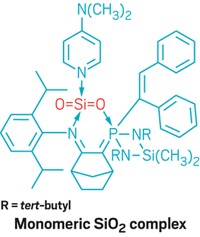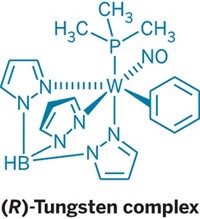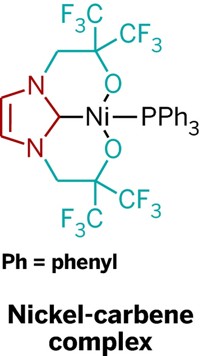Advertisement
Grab your lab coat. Let's get started
Welcome!
Welcome!
Create an account below to get 6 C&EN articles per month, receive newsletters and more - all free.
It seems this is your first time logging in online. Please enter the following information to continue.
As an ACS member you automatically get access to this site. All we need is few more details to create your reading experience.
Not you? Sign in with a different account.
Not you? Sign in with a different account.
ERROR 1
ERROR 1
ERROR 2
ERROR 2
ERROR 2
ERROR 2
ERROR 2
Password and Confirm password must match.
If you have an ACS member number, please enter it here so we can link this account to your membership. (optional)
ERROR 2
ACS values your privacy. By submitting your information, you are gaining access to C&EN and subscribing to our weekly newsletter. We use the information you provide to make your reading experience better, and we will never sell your data to third party members.
Synthesis
First Four-Coordinate Iron(III) Porphyrin
January 21, 2008
| A version of this story appeared in
Volume 86, Issue 3
Chemistry professor Kenneth S. Suslick, graduate student Ming Fang, and crystallographer Scott R. Wilson of the University of Illinois, Urbana-Champaign, report the first four-coordinate Fe(III) porphyrin complex, a rare example of isolating an extremely reactive electrophilic metal cation (J. Am. Chem. Soc. 2008, 130, 1134). The researchers created the complex by reacting a hydroxy-substituted iron porphyrin with triisopropyl chlorosilane to form a sterically hindered bis-pocket siloxyl porphyrin. They further replaced an original chloro ligand with a series of weakly coordinating anions. Several of these anions formed four-coordinate Fe(III) porphyrins in solution, but only the very weakly coordinating hexabromocarborane anion formed the four-coordinate Fe(III) structure in both solution and crystalline forms. In the solid phase, other anions such as triflate enter the porphyrin pocket and coordinate the ion, but the bulky carborane remains fully outside the porphyrin pocket, leading to the isolated cation. Suslick suspects the approach to make electrophilic metal cations won't be limited to porphyrins. "The right combination of steric hindrance might work for other complexes," he says.





Join the conversation
Contact the reporter
Submit a Letter to the Editor for publication
Engage with us on Twitter